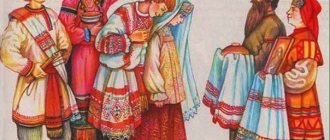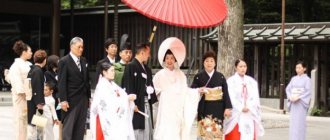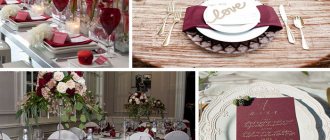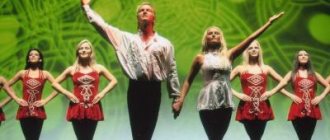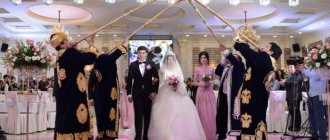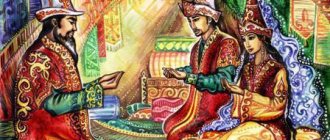Recently, young people have begun to show genuine interest in the old traditions of Slavic weddings. The original and largely unique customs of our ancestors are often quite organically woven into modern marriages.
A wedding is an incredibly important event in the life of every person, requiring careful preparation and marking a new stage in the life and relationships of lovers. The ancestors treated this event with due respect and trepidation, and therefore it is not surprising that the traditions of the Slavic wedding are attractive to those engaged today.
Traditions, customs and rituals
The ancient Slavs considered creating a family one of the most important stages of their lives, while relying on the mercy of fate and favor from above. The word “wedding” consisted of three parts, fully expressing the attitude of the ancestors to this event: “sva” meant heaven, “d” - an earthly act, and “ba” - blessed by the gods. This decoding could be formulated as “an earthly deed blessed by the gods in heaven.” The statement also determined the nature of all ancient rituals at a Slavic wedding.
The union of two people has always been traditionally associated with procreation, and the birth of children was encouraged in every possible way. In connection with this, the ancient Slavs gradually developed several restrictions and prohibitions for candidates for potential bride and groom. The age limit for newlyweds was very reasonable: the young man must be over 21 years old, and the girl must be 16 years old. For well-known reasons, the clan of the groom and the clan of the bride should not intersect too closely.
A popular misconception is that young people were often married against their will. In fact, the traditions of the Slavic wedding assumed the presence of a special, harmonious connection between the newlyweds. It was believed that life itself and the gods guided them into each other's arms.
If we talk about Old Slavic traditions and customs, then until now they have been repeatedly subject to changes due to constant migrations and wars. The birth of Christianity in Rus' marked changes in wedding rituals, weddings began to take place in the church, and the blessing of the newlyweds by the gods at the temple was forgotten as one of the many pagan traditions.
Vyunishnik (junins).
Everyone is well aware of such pre-wedding traditions as a bachelorette or bachelor party. But among the Slavs, a wedding was not a matter of one day, but of an entire period. It began long before the combination and continued after. Not only the newlyweds, but also everyone around them took part in the ceremony. Vyunishnik included congratulations, round dances, glorification, and honoring of the newlyweds who got married during the current year. The purpose of this ritual is to help young people move into a new, unusual life. Organizing a wedding is a labor-intensive task, so it’s convenient to turn to professionals, for example https://magmarry.ru/organizacija-vyezdnoj-ceremonii.htm
It's better if you have a rough idea of the scenario. In this case, cooperation with the organizers will be as effective as possible. We hope that the above traditions will be useful at your beautiful, conscious wedding. We wish you love and understanding for many years to come!
Stylistics and symbolism
The Slavic wedding style was based on the idea of unity with nature and honoring traditions. The clothes and surroundings did not imply the excesses and frills of modern wedding celebrations, and did not exude excessive pathos and formulaic style. The atmosphere, as a rule, is maintained in the Old Russian style. It is encouraged to decorate the festival site with as many natural elements as possible and the absence of synthetic and plastic parts. Typically the color palette for costumes, decorations and backgrounds is based on white and red, but shades of blue are also acceptable.
An ancient amulet called the wedding, denoting the creative and destructive principles of the sun and therefore possessing double power, can rightfully be called the main symbol of the Slavic wedding. In a general sense, this talisman personified the unification of two families, protected the future family from the evil eye and all troubles, and also brought prosperity, mutual understanding and happiness to the home of the married couple. According to tradition, the parents of the newlyweds should give the wedding gift after all the ceremonies are completed.
The ancient Slavs believed that this talisman had magical properties that contributed to the creation of a family microclimate, helped the early appearance of healthy offspring and protected spouses from squabbles and quarrels. One of the rituals of a Slavic wedding prescribed that after the birth of the first child, the bridegroom along with the veil, dress and other attributes of the celebration should be hidden in a chest. However, some couples still left the symbol in the most visible place in the house.
Nowadays, it has become popular to apply the image of this amulet in the form of the same tattoo to both spouses. It is worth noting that according to Old Slavic traditions, such a talisman is not considered real and does not have magical properties. According to ancient customs, the wedding dress was made by embroidering with natural threads on a piece of white fabric. The talisman could then be hung on the wall like a painting. Preference was given to fabrics of linen origin. Some chose a wooden talisman made of beech, oak, ash or birch.
Clothes with sacred patterns
The main color of the Slavic ornament at a wedding is red. This is the color of life, fire, energy, beauty. The words red and beauty are undoubtedly connected: the maiden is red, the sun is red. The main symbol is the Kolovrat, or saltworker. Signs similar to the swastika first appeared among the Slavic peoples. This is the most revered sign, a powerful amulet. It embodies the unity of the clan, the change of generations, seasons, the rotation of everything. It was customary to wear ochelya - a protective headband for both men and women. Wreaths convey to the newlyweds the powers of eternal Love and the Sun, which is hidden in the grass and flowers.
Headband and belt. Recommendations for wearing in social life
Headband and belt. Recommendations for wearing in social life. ⇒ If a woman wears bangs, covers her forehead,...
Wedding ceremony. Slavic traditions.
From time immemorial, Slavic wedding ceremonies were not performed for the sake of a beautiful show! Before starting a new family,...
Scenarios for weddings
The essence of any wedding scenario in the Old Slavonic style lies in the naturalness of the theme. Various established wedding templates should be abandoned immediately. The atmosphere of celebration, bright colors and unbridled fun is the foundation for writing a script for a Slavic wedding. Already at this stage it is time to decide who will get the role of the leader. A professional toastmaster will most likely cope with this task better, but he must be warned in advance about the style of the celebration and discuss all the details.
According to Slavic customs, at a wedding it is customary to make up a wedding train, which is necessarily attended by the bride and groom, parents on both sides, friends of the groom and bridesmaids, as well as professional musicians. The young man, accompanied by his retinue, goes first of all to his beloved, and then goes with her to the place of the wedding ceremony. At this time, the guests are already waiting for the celebration to begin. Contrary to established European traditions, the bride should be led to the altar not by her father, but by the groom himself. Then the official part of the event begins, during which the newlyweds swear their love to each other, exchange wedding rings, sign their consent to marry and kiss to the applause of the guests.
Old folk entertainments and colorful competitions of those times will fit well into the scenario of a Slavic wedding. The public will positively appreciate the tug of war, trickle, tag and competition in small towns. The ancient Russian sport of jumping over a fire will increase the level of fun. Of course, with full compliance with all safety measures. Heroes of Slavic folklore and folk tales will only brighten up the holiday. Charming mermaids, frightening goblins and mysterious brownies will perfectly fit into the atmosphere of a real Slavic wedding.
To please the ears of guests, you can invite musical groups to perform songs accompanied by Russian folk instruments such as gusli, domra, hurdy-gurdy or the well-known balalaika. It is recommended to supplement the string group with wind instruments: a shepherd's trumpet, a penny, a kalyuk, a flute or a horn. Keeping the rhythm of vigorous Slavic dances and dances should be entrusted to a drum group consisting of tambourines and bells, rattles and rattles. The size and composition of the Slavic orchestra will depend only on financial capabilities. Guests will certainly appreciate the ostentatious fist fights accompanied by lively musical tunes. Undoubtedly, it is best to use the services of professional artists to conduct such fights.
Wedding table decoration
The banquet plays a special role in organizing a celebration in Old Russian traditions. The table decoration at a Slavic wedding should be made as varied and rich as possible. Residents of Ancient Rus' gathered entire villages for such events, and therefore the tables practically sagged under the huge number of treats for every taste. The dishes invariably included various pastries, meat and fish dishes, and at the head of the table there was always a loaf, which was entrusted to bake by married women from the bride’s clan. Of course, organizing a Slavic wedding currently allows for ordering a loaf from a bakery. The most interesting thing is that a large loaf can fully replace a wedding cake and once again emphasize the Slavic flavor of the event.
It is also necessary to decide on a list of dishes for the table that will be both tasty and consistent with the overall style of the celebration with a Slavic twist. The banquet menu in this case may consist of an impressive selection of treats:
- pies, pancakes and pancakes,
- baked fish and salted herring,
- game and spit-roasted meat (rabbit, pork or beef),
- pickled mushrooms and various pickles,
- caviar and sauerkraut,
- suckling pig as an exquisite delicacy.
The list of drinks includes compotes, fruit drinks, jelly and uzvar. The latter are decoctions of boiled water with fruit, berry and wine additives to taste. In principle, it is quite acceptable to leave traditional wedding drinks like champagne and some strong alcohol on the menu. If you pour strong alcohol into jugs and decanters stylized to resemble Slavic life, this will only benefit the holiday atmosphere.
Themed wedding photo shoot
The newlyweds can have a wedding photo shoot in a stylized restaurant, but beautiful landscapes - a river, forest, wheat field, countryside - would be more appropriate for a Slavic celebration. Brainstorm different ideas for your shoot with your photographer. For this purpose, you may want to beautifully decorate the lawn of a private home or decorate the backyard of a restaurant.
Wedding gifts
The ancient Slavs strictly followed established procedures and always knew who and how much should give as a gift so that everyone present would be satisfied. Back then they could give anything that could be useful in everyday life and at the same time personified wealth and well-being. Poultry and animals were used: the young were given geese, ducks, chickens, piglets, cows, bulls and calves. It was not forbidden to provide even food as a gift. From what to give for a wedding in the Slavic style at the present time, we can mention towels without fringe, which were a symbol of the unity and love of the married couple. By the way, ancient Slavic customs prescribed giving gifts of something in large quantities and always in multiples of ten. For example, one hundred boxes of chicken eggs or ten geese.
The eldest relative in the groom's family traditionally gave him a whip. The groom was supposed to place this whip on a prominent part of the wall in the house. The symbolism in this case was to demonstrate the power of the husband over his wife. Other relatives were also supposed to present certain gifts according to the traditions and customs of the Slavic wedding. For example, the future mother-in-law usually gave her daughter-in-law some valuable family heirloom. With this gift, the mother-in-law bequeathed to keep family traditions in the house of the future married couple. A ring or any other decoration acted as a relic.
Of course, many will consider gifts like geese and whips a little strange for a modern wedding. However, in Old Slavic times, the young were often given elegant furs and textiles, as well as beautiful jewelry, as gifts. These gifts are unlikely to ever go out of fashion. Also, ordinary household items will always remain relevant as a present. It won’t be difficult to find a useful gift from kitchen and household appliances, dinnerware sets and sets, sports equipment and entertainment devices.
An interesting tradition was the so-called “gifts”. In the first six months of married life, husband and wife assessed gifts from guests at the wedding. After this, they made sure to pay a personal visit to each guest and presented him with reciprocal gifts, which in value exceeded the wedding gifts they had previously been given. The meaning of this custom was that the family showed the value of the gifts received and how these gifts increased their family wealth.
A wedding ceremony performed in heaven
People have almost forgotten that an event such as a wedding changes future destinies at the upper subtle level of our existence. The world of Rule and Navi blows directly on us, innocently living in the material, manifest world, existing here and not here at the same time. This is the world of the highest Gods who created this universe in the middle of the destructive breath of the surrounding Chaos.
The wedding ceremony of two in this subtle world sets armies in motion. The Gods of Rule are actively involved in this most important event. At the same time, precisely at the hour when the bride, fulfilling the Slavic traditions of the wedding, undoes her maiden braid in her mother’s house, puts on a white closed shirt and says goodbye to her father’s Churs - the Guardians, in order to begin her wedding train, an army of navys, ugly and senseless, trumpets the muster creatures of Chaos.
The ceremony of unbraiding the braid. Veles circle
It is at this hour that the soul of a woman, left without parental patrons, represents for them a tasty prey, a most valuable prize, a ground for envy, flattery, fear and resentment! The bride goes to the sacred fire, where the Chura-Patron husbands are waiting for her, and at this time she is vulnerable to the penetration of incorporeal navias as never before. That is why the bride should wear a long dress with sleeves, and her head should be covered with thick fabric. No need to take risks! Wedding ceremonies do not allow the bride to wear open dresses!
Traditional bridal veil. Veles circle
Folk songs for a wedding
No wedding banquet can be complete without singing positive songs, and even more so at a Slavic wedding. Both guests of the celebration and the newlyweds themselves, as well as professional musicians performing songs to the accompaniment of Old Church Slavonic instruments, can sing. The repertoire should be selected when preparing the wedding script either on your own or by listening to the ideas of the musicians you plan to hire.
In Ancient Rus', special attention was paid to ritual chants. Slavic folklore distinguished wedding songs as one of four main genres. At the celebration, they served as a figurative and expressive means with a number of literary devices: personification, the presence of constant epithets, comparisons and diminutive suffixes to designate the bride, groom and all members of the young family.
In fact, ritual songs among the Slavs were a unique combination of folk eloquence, Slavic mythology, elements of oral poetry and an encyclopedia about the life of the simple peasant people of those times. Many songs use the technique of idealizing the image and characters of the bride and groom and have extraordinary brightness in depicting plots. The motives of wealth, happiness and well-being of the young are also at the forefront. The groom is often compared to a drake or falcon, and the bride to a duck or cuckoo. It is interesting that the image of a cuckoo symbolizes a funeral. The ancient Slavs associated this with the initiation rite, according to which the future bride had to “bury” her past life and start a new life together with her husband from scratch. The symbol of the cuckoo is mentioned precisely in songs at a bachelorette party and during the girl’s departure to the crown for the wedding ceremony.
The repertoire of Slavic songs for weddings offers several dozen works that fit perfectly into the holiday atmosphere even today. A list of the most popular ones can be found below. The spelling and style of writing have been preserved. For the most part, titles are the first line of song lyrics, from which the full text can easily be found on the corresponding information resources.
Lyrical songs for a wedding in the Slavic style, performed directly at the festive banquet, are as follows:
- “The birch tree bowed to the dark forest...”
- “The duck swam at the sea...”
- “Why are you a birch splinter, you don’t burn brightly...”
Ritual and ceremonial songs for a wedding in the Slavic style:
- “Like a matchmaker in the yard...” - the song announced the beginning of the ceremony to congratulate the groom and sounded exactly at the moment when the bride’s parents gave their consent to the wedding.
- “The soap dish started up, like our girls...” - talks about the bath ceremony in the bride’s house.
- “All the boyars have moved into the courtyard...” - it was sung either at a bachelorette party or upon the arrival of the groom. It could also be performed at the wedding itself.
- “And the duck swam…” - the song was supposed to be sung at a bachelorette party, when the bride unbraided her braid.
- “The cuckoo was cuckooing in the little garden...” - this song is sung at the celebration itself, symbolizing the conventional designation of the wedding process using figurative means of allegorical speech.
- “A birch tree stood at the gate...” is a calendar ritual song. It implies the bride’s entry into a new role as mother and continuer of the man’s family.
Decoration of the banquet area
The true Russian spirit will be brought into the interior by:
- old Russian stove;
- brightly painted dishes;
- wooden utensils with red and gold ornaments;
- dried flowers;
- sheaves and ears of corn;
- nesting dolls;
- baskets;
- rocker arms and buckets;
- sleighs and wooden carts;
- wicker fences;
- bunches of ripe viburnum;
- rowan beads;
- fagots of bagels;
- fagots of garlic and onions;
- dried berry branches;
- apple motifs in decor;
- painted samovars;
- wooden bowls and spoons;
- button accordions;
- felt boots and bast shoes;
- kokoshniks;
- clay dishes;
- an abundance of satin ribbons;
- wreaths of fresh flowers;
- linen embroidered tablecloths;
- wooden tables;
- wooden benches with carvings on the backs;
- figures of swans.
The arrangement of tables and benches can be very diverse. In the old days, tables were placed in a long row or in the letter P. In the center of the table, an area for the young was decorated, or a separate table was placed for them.
Choosing a wedding dress, outfits for the groom and guests
Without characteristic costumes it is simply impossible to fully convey the full flavor of the celebration. In addition, photos of guests in outfits corresponding to the style of the event taken at a Slavic wedding will become a wonderful memory for the newlyweds. You should approach the choice of a wedding dress for the bride and an outfit for the groom even more responsibly.
Typically, the bride's attire involves a white sundress with red ethnic patterns in a traditional style. For a slightly less authentic option, a white and red dress is suitable, which will surely be found in any wedding salon. If the combination of red and white does not suit you, you can try a combination of snow-white and blue shades. Many organizers insist that the decoration of a Slavic wedding be in the same colors as the bride’s dress.
For footwear, you should take a closer look at red shoes or fabric boots in the Old Church Slavonic style of the same color. For a winter wedding, the bride will look good with patterned white felt boots in combination with a fur coat, muff and winter hat. In spring and autumn, it is permissible to cover yourself with a colored shawl or scarf.
Experts consider loose curls and slightly careless styling to be one of the most suitable hairstyles for Slavic style. The custom in Ancient Rus' ordered girls to wear one braid before marriage, and after that the braid was unraveled, and then they were supposed to braid two braids. It is worth clarifying that there is no veil at a wedding in the Slavic style; instead, a kokoshnik or wreath is worn. Modern girls would rather leave their heads uncovered and decorate their hair with a hair clip. If there is still a wreath, then after the official paintings at the wedding the bride must give it to her mother.
If the newlyweds have decided on a bride's dress suitable for a Slavic wedding, all that remains is to choose a moderately authentic, stylish suit for the groom. There are two main styles of outfit colors to choose from: red and black colors with golden patterns or an all-white outfit with ethnic patterns. The groom usually wears fabric boots on his feet. Mandatory elements, regardless of the color palette, are trousers and a long shirt tied with a sash.
It is necessary to accurately match the patterns on the groom's suit and the bride's dress. Ornaments at Slavic ritual weddings usually designated one of the ancient gods and were something of an offering for the protection and blessing of the union by higher powers.
The color requirements for the guests' outfits were not as strict as those for the heroes of the occasion. Suits of all natural colors were allowed, including green, blue or orange. Girls are free to choose dresses of any length, respecting the authenticity and general style of the Slavic surroundings. Men's suits should mainly consist of trousers and long shirts with sashes.
Groom image
The main rule for the groom when choosing his outfit is complete harmony in color with the image of the bride.
According to Russian folk traditions, the groom wears the following ensemble:
- Black wide-leg trousers with cuffs at the hem.
- A shirt with long sleeves and the same trim as the beloved's dress.
- Wide red sash.
- Black boots (pants tucked into them).
- A cap with a visor (a Slav must attach a large flower).
To enhance the look, you can put a vest on the shirt and sew on gilded buttons.
Slavic symbols were hand-embroidered as amulets on newlyweds’ outfits:
- star, cross of Svarog;
- Belobog;
- Bogodar;
- sign of Spiritual Power.
These signs are designed to protect, bring prosperity and prosperity, and fill a young family with wisdom and strength throughout their lives.
Choosing a venue, designing and decorating the hall
Many newlyweds try to hold their wedding celebration in one of the summer months. However, organizing a Slavic wedding is acceptable both in the warm season and in winter frosts. Holding the event in winter will only add to the ambience, since the action of most Old Russian fairy tales took place precisely in the cold season.
When choosing a location, you can give preference to a real Russian hut with a chimney, wooden shutters on the windows and a well behind the threshold. Wooden interior and exterior decoration will play a key role in styling. Finding houses in a dense coniferous or birch forest in the autumn, when everything around is already strewn with yellowed foliage, will add special charm to the celebration.
As for a summer wedding in the style of Ancient Rus', everything is much simpler here. You can hold such an event right in nature, for example, go to a wheat field. In a nice and cozy place in the open air it is possible to conduct registration, a photo session and the celebration itself with a banquet. A less radical option is to rent a summer veranda in a restaurant with a suitable design style. The interior welcomes the presence of a real Russian stove, fireplace, towels, wicker fences and wooden furniture.
The color palette can be made up of red, burgundy, dark pink, blue and orange shades. The design of the hall for a Slavic wedding must also be based on white color. Summer is more conducive to warm, calm tones like pink, and in winter red in combination with snow-white snowdrifts will look best. In turn, it was the red color that occupied a special place in the Old Slavic style. In addition, it was already mentioned above that the best option would be to combine the color design of the hall with the color of the bride’s wedding dress.
Of the generally accepted decorative items for decorating the hall for a wedding in the Slavic style, it is recommended to select those listed below:
- Textiles such as chintz curtains, knitted rugs, towels and patchwork tablecloths.
- Musical instruments such as balalaikas, gusli, rattles, harmonicas, tambourines, button accordions and accordions.
- Gifts of nature like pine cones, bunches of rowan and spruce branches.
- Buckets and rockers.
- Sleighs and carts.
- A replica of a Russian stove.
- Samovars and baskets.
- Small and large nesting dolls.
What to wear for guests - dress code
The theme, event scenario, and desired dress code are indicated in the invitations so that guests can prepare in advance and choose clothes suitable for special occasions and folk entertainment.
In an ideal Russian wedding, everyone is dressed in the same Slavic style of a given era. To do this, you will most likely have to rent costumes and organize dressing changes.
It is much easier to complement the guests’ clothing with some spectacular details: a hairstyle, easy accessories, boutonnieres, jewelry, a rowan buttonhole for men and a wreath of herbs for women.
This approach will fill the holiday with a Russian flavor that matches the plan.
Ideas for a photo shoot in Slavic style
First of all, you need to ensure that the props for decorating the celebration itself are used as much as possible in the photo shoot, which should be initially mentioned to the hired photographer. The bride and groom can pose against the backdrop of a wheat field or river bank. Ancient Russian-style huts, haystacks and horse corrals will serve as excellent thematic backdrops for photos at a Slavic wedding.
There are also many different scenes for winter photography, for example, young people sit down at the table, the bride pours tea from a samovar into cups. Winter sleds will also be a great prop for photography. Some go even further and film voluminous wedding productions in the style of Russian fairy tales like Morozko.
The bride's bouquet
A wedding bouquet is an old Slavic tradition. Previously, newlyweds' costumes looked completely different; there were no shoes or veils that were familiar to us. The festive outfit had a different look, but the bride had flowers even then. A wreath was an indispensable attribute of a Slavic wedding; the girl wove it from wildflowers and herbs. A newlywed who is about to celebrate in a national style should choose floral arrangements in white, red or blue - these tones are traditionally considered festive. Chamomiles, buttercups, poppies, cornflowers will be a wonderful addition to the bride's image.
Other features of wedding preparations
Taking into account all the traditions and rituals of Slavic weddings is an extremely difficult task. If the main points are more or less clear, all that remains is to clarify some details. No wonder they say that the devil is in the details.
Small themed gifts for guests will be a kind gesture from the newlyweds. Such pleasant little things can include sweet cockerels on sticks, beautiful amulets and nesting dolls, as well as painted plates and saucers stylized in the Slavic style. Towels and bath brooms are also suitable as symbolic gifts.
Organizing banquets with an impressive number of guests does not always go smoothly. One of the useful little things can be called special cards with the names of people invited to the wedding. Such cards are made from simple cardboard and placed in those places that are intended for specific guests at the banquet. For authenticity, it is allowed to place cards on small wooden barrels or stumps. Dried grass is scattered around the card.
It is certainly worth mentioning wedding invitations, which also should not deviate from the general Old Slavonic style. The front side of the invitations is usually decorated with an image of two roosters, a loaf of bread and photographs of lovers in themed outfits. The newlyweds hold wooden wine glasses in their hands. Red and white embroidery can decorate the edges of the invitations. Some people prefer to change the very shape of standard invitations and make them in the form of a nesting doll or a cockerel with the appropriate color design.
In conclusion, it should be added that the traditions and rituals of a Slavic wedding are truly fascinating and original. This style is perfect for the most important event in the lives of young people. A high-quality approach to organizing a celebration will allow the newlyweds and guests to plunge into the real atmosphere of Old Slavic holidays and visit a fairy tale.
Pagan rituals of ancient Rus': funeral ceremonies
So, the essence of the burial was to help the soul separate from the deceased body, go to Nav, wait out the next cycle of nature there and appear on Earth in a new guise.
A special boat was prepared for this. They installed Krada on it - a structure made of sticks, dry herbs and incense. The body of the deceased and gifts to the Navi Gods were placed in the center of Kradu so that they would accept the soul of the deceased.
At sunset, Krada was set on fire and launched into the water. The fire was supposed to show the soul the way and completely break the connection with the physical world that he left. At this time, relatives and friends on the shore honored the deceased man.
Important: in those regions where it was not possible to use a reservoir, the funeral rite was slightly modified: after burning the body, the ashes were collected in a special vessel and stored in a mound. Often the personal belongings of the deceased were placed there so that his life in the afterlife would be comfortable.
And the Eastern Slavs sometimes took a pot of ashes for some time to a crossroads near the settlement where the deceased lived and covered it with a special wooden structure. In this way, the deceased relative was given the opportunity to say goodbye to his place of residence and choose his path in the afterlife.
You can learn more about pagan rituals from the video:
